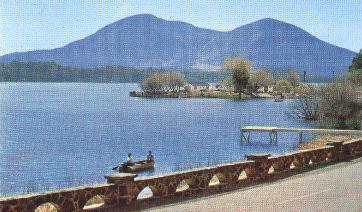

Lake County, CaliforniaHistory of the County |

The county was formed May 20, 1861, and was made up of land taken mainly from Napa County with the northwest portion taken from Mendocino County and some of the eastern portion came from Colusa County. Probably over 99% of the population is in the southern 1/3 of the county. The northern portion is mostly the Mendocino National Forest and includes a portion of the Snow Mountain Wilderness area.
The area was home to the Pomo Indians before Salvador Vallejo brought in his cattle in 1839 and a few (very few) pioneers began arriving in the area in about 1845. These were mostly cowboys herding cattle for General Vallejo or single men exploring new country. In 1848 Walter Anderson and his wife and a Mr. Beeson arrived in what is now the Lower Lake area. (Walter Anderson moved on to Mendocino Co. to the valley that bears his name).
The first GROUPS of settlers started arriving in 1854. The Hammack Wagon train of about 25 people arrived in Big Valley, near what is now Kelseyville in April of 1854, with smaller groups arriving a few days later. In May of 1854, Benjamin Dewell and his wife Celia Elliott Dewell (both in the Bear Flag Revolt) moved to the Upper Lake area from Sonoma County. Celia's parents (William B. Elliott) and her siblings arrived later, in the fall. The Copsey wagon train arrived in the Lower Lake area in 1856. So, by this time, the county was becoming "settled".
When the county was formed in 1861, Lakeport won the vote to become the county seat and the courthouse was built. For some reason, in 1864, another vote was taken on the county seat, with Lakeport winning again. On February 15, 1867, the courthouse mysteriously burned down, thus losing all of our vital records from 1861 to February 1867 (any vital records that existed before 1861 are in Napa County). A new election was held and this time Lower Lake won the right to be the county seat. In 1870 the 4th and final vote was taken on the county seat, with Lakeport winning. And, it has remained the county seat since then.
As some of the new pioneers explored the county, they discovered many mineral and hot springs. During the late 1800s and early 1900s, Lake County was "THE" resort area, with some very large, elaborate hotels being built in some of the most remote, mountainous areas imaginable. Because, of course, the Springs were in the mountains. People would travel from the cities for several days to get to these resorts, and then stay for 2 or 3 months at a time. Getting to the area was no easy feat, since the county has never had a railroad, and the mountain roads were not built for comfort. The visitors traveled by train, stage coach, many times by boat to cross the lake, and then by stage coach again.
Nearly all of the Mineral Springs resorts met the same fate - Forest Fires!, with only a couple (Witter Springs and Highland Springs Resorts) being torn down.
There is only a little "light industry", with the main income being from tourism and agriculture. The county has always been mainly an agriculture county, shifting from generalized farming to large Bartlett Pear orchards, Walnut orchards, and some livestock. Now, almost everything has been planted to wine grapes, with just a few walnut and pear orchards left.
There are two incorporated cities - Lakeport & Clearlake (not to be confused with the lake itself - Clear Lake); 8 small towns: Kelseyville, Lower Lake, Middletown, Clearlake Oaks, Glenhaven, Lucerne, Nice & Upper Lake, and numerous "communities" built around the modern day resorts.
The negative side of living here...slow traffic on the curvy, two-lane highway around the lake and through the mountains.
The positive side...We are rated as having some of the cleanest air in the State.
And...we just got our 11th stoplight in the county (but another will be activated soon). And now, in 2019, we have 2 existing roundabouts on State highways, with 1 and possibly 2 more planned.
 |
Anita Crabtree anitajc@pacific.net Last Updated 01/26/2020 |
Copyright © 1996-2020: by the Lake County Coordinator: All materials, images, sounds and data contained herein are not to be copied or downloaded for purposes of duplication, distribution, or publishing without the express written permission of the Lake County Coordinator.
This web page is maintained on behalf of the California portion of The USGenWeb Project and is paid for by Supporters. Although believed to be correct as presented, we ask that if you have corrections, changes, additions, or find that any links provided on this page are not functioning properly please contact the Webmaster for prompt attention to the matter. ~ALL RIGHTS RESERVED~